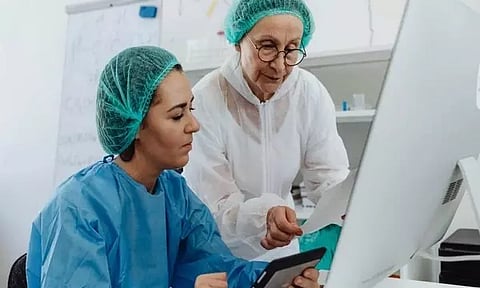

MASSACHUSETTS: Researchers have devised a growth chart for tracking muscle mass in growing youngsters using artificial intelligence and the largest paediatric brain MRI dataset to date.
The new study, led by Brigham and Women's Hospital, a founding member of the Mass General Brigham healthcare system, discovered that their artificial intelligence-based tool is the first to offer a standardised, accurate, and reliable way to assess and track muscle mass indicators on routine MRI.
Their findings were published in Nature Communications today.
"Pediatric cancer patients often struggle with low muscle mass, but there is no standard way to measure this. We were motivated to use artificial intelligence to measure temporalis muscle thickness and create a standardized reference," said senior author Ben Kann, MD, a radiation oncologist in the Brigham's Department of Radiation Oncology and Mass General Brigham's Artificial Intelligence in Medicine Program.
"Our methodology produced a growth chart that we can use to track muscle thickness within developing children quickly and in real-time. Through this, we can determine whether they are growing within an ideal range." Lean muscle mass in humans has been linked to quality of life, daily functional status, and is an indicator of overall health and longevity.
Individuals with conditions such as sarcopenia or low lean muscle mass are at risk of dying earlier, or otherwise being prone to various diseases that can affect their quality of life. Historically, there has not been a widespread or practical way to track lean muscle mass, with body mass index (BMI) serving as a default form of measurement.
The weakness in using BMI is that while it considers weight, it does not indicate how much of that weight is muscle. For decades, scientists have known that the thickness of the temporalis muscle outside the skull is associated with lean muscle mass in the body.
However, the thickness of this muscle has been difficult to measure in real-time in the clinic and there was no way to diagnose normal from abnormal thickness. Traditional methods have typically involved manual measurements, but these practices are time-consuming and are not standardized.
To address this, the research team applied their deep learning pipeline to MRI scans of patients with pediatric brain tumors treated at Boston Children's Hospital/Dana-Farber Cancer Institute in collaboration with Boston Children's Radiology Department.
The team analyzed 23,852 normal healthy brain MRIs from individuals aged 4 through 35 to calculate temporalis muscle thickness (iTMT) and develop normal-reference growth charts for the muscle.
MRI results were aggregated to create sex-specific iTMT normal growth charts with percentiles and ranges. They found that iTMT is accurate for a wide range of patients and is comparable to the analysis of trained human experts.
"The idea is that these growth charts can be used to determine if a patient's muscle mass is within a normal range, in a similar way that height and weight growth charts are typically used in the doctor's office," said Kann.
In essence, the new method could be used to assess patients who are already receiving routine brain MRIs that track medical conditions such as pediatric cancers and neurodegenerative diseases.
The team hopes that the ability to monitor the temporalis muscle instantly and quantitatively will enable clinicians to quickly intervene for patients who demonstrate signs of muscle loss, and thus prevent the negative effects of sarcopenia and low muscle mass.
One of the limitations lies in the algorithm's reliance on scan quality, and how a suboptimal resolution can affect measurements and the interpretation of results. Another drawback is the limited amount of MRI datasets available outside of the United States and Europe that can give an accurate global picture.
"In the future, we may want to explore if the utility of iTMT will be high enough to justify getting MRIs on a regular basis for more patients," said Kann.
"We plan to improve model performance by training it on more challenging and variable cases. Future applications of iTMT could allow us to track and predict morbidity, as well as reveal critical physiologic states in patients that require intervention."